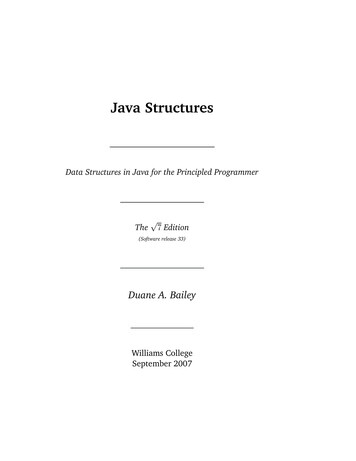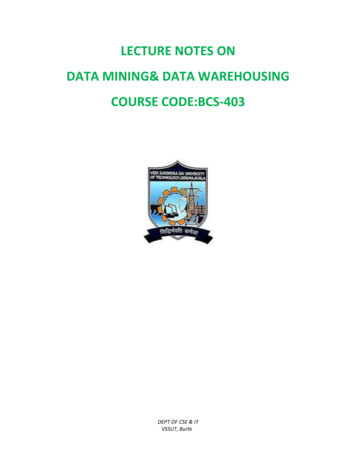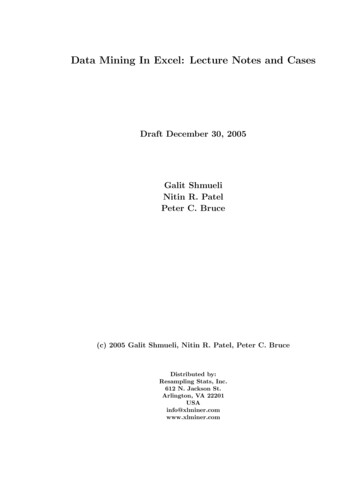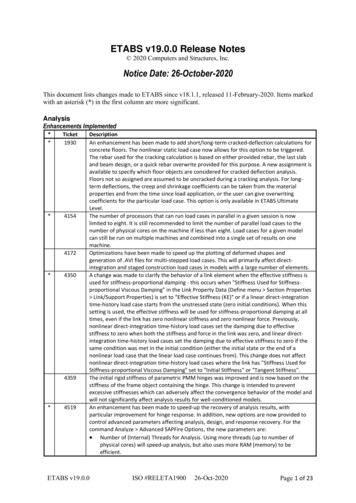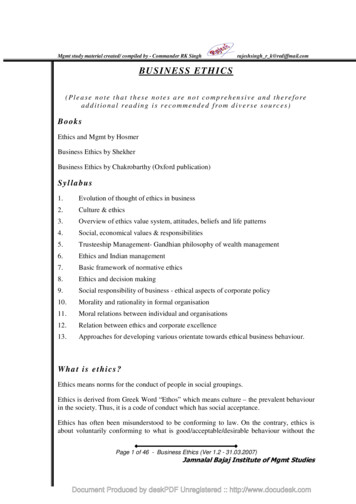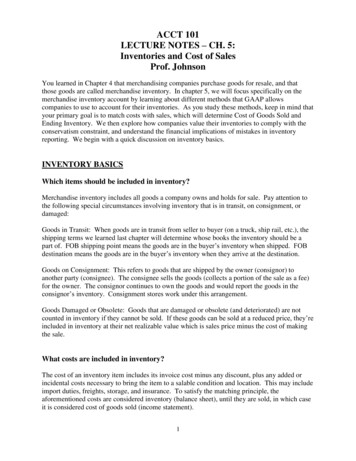
Transcription
Lecture Notes forData Structures and AlgorithmsRevised each year by John BullinariaSchool of Computer ScienceUniversity of BirminghamBirmingham, UKVersion of 27 March 2019
These notes are currently revised each year by John Bullinaria. They include sections based onnotes originally written by Martı́n Escardó and revised by Manfred Kerber. All are membersof the School of Computer Science, University of Birmingham, UK.c School of Computer Science, University of Birmingham, UK, 20181
Contents1 Introduction1.1 Algorithms as opposed to programs . . . . .1.2 Fundamental questions about algorithms . .1.3 Data structures, abstract data types, design1.4 Textbooks and web-resources . . . . . . . .1.5 Overview . . . . . . . . . . . . . . . . . . . . . . . . . . .patterns. . . . . . . . .5567782 Arrays, Iteration, Invariants92.1 Arrays . . . . . . . . . . . . . . . . . . . . . . . . . . . . . . . . . . . . . . . . . 92.2 Loops and Iteration . . . . . . . . . . . . . . . . . . . . . . . . . . . . . . . . . 102.3 Invariants . . . . . . . . . . . . . . . . . . . . . . . . . . . . . . . . . . . . . . . 103 Lists, Recursion, Stacks, Queues3.1 Linked Lists . . . . . . . . . . . . .3.2 Recursion . . . . . . . . . . . . . .3.3 Stacks . . . . . . . . . . . . . . . .3.4 Queues . . . . . . . . . . . . . . . .3.5 Doubly Linked Lists . . . . . . . .3.6 Advantage of Abstract Data Types.4 Searching4.1 Requirements for searching . . . . . . . .4.2 Specification of the search problem . . . .4.3 A simple algorithm: Linear Search . . . .4.4 A more efficient algorithm: Binary Search5 Efficiency and Complexity5.1 Time versus space complexity . . . . .5.2 Worst versus average complexity . . .5.3 Concrete measures for performance . .5.4 Big-O notation for complexity class . .5.5 Formal definition of complexity classes.12121516171820.2121222223.2525252626296 Trees316.1 General specification of trees . . . . . . . . . . . . . . . . . . . . . . . . . . . . 316.2 Quad-trees . . . . . . . . . . . . . . . . . . . . . . . . . . . . . . . . . . . . . . 326.3 Binary trees . . . . . . . . . . . . . . . . . . . . . . . . . . . . . . . . . . . . . . 332
6.46.56.66.76.8Primitive operations on binary treesThe height of a binary tree . . . . .The size of a binary tree . . . . . . .Implementation of trees . . . . . . .Recursive algorithms . . . . . . . . .7 Binary Search Trees7.1 Searching with arrays or lists . . . . . . . . . . . . . .7.2 Search keys . . . . . . . . . . . . . . . . . . . . . . . .7.3 Binary search trees . . . . . . . . . . . . . . . . . . . .7.4 Building binary search trees . . . . . . . . . . . . . . .7.5 Searching a binary search tree . . . . . . . . . . . . . .7.6 Time complexity of insertion and search . . . . . . . .7.7 Deleting nodes from a binary search tree . . . . . . . .7.8 Checking whether a binary tree is a binary search tree7.9 Sorting using binary search trees . . . . . . . . . . . .7.10 Balancing binary search trees . . . . . . . . . . . . . .7.11 Self-balancing AVL trees . . . . . . . . . . . . . . . . .7.12 B-trees . . . . . . . . . . . . . . . . . . . . . . . . . . .8 Priority Queues and Heap Trees8.1 Trees stored in arrays . . . . . . . . .8.2 Priority queues and binary heap trees8.3 Basic operations on binary heap trees8.4 Inserting a new heap tree node . . . .8.5 Deleting a heap tree node . . . . . . .8.6 Building a new heap tree from scratch8.7 Merging binary heap trees . . . . . . .8.8 Binomial heaps . . . . . . . . . . . . .8.9 Fibonacci heaps . . . . . . . . . . . . .8.10 Comparison of heap time complexities.9 Sorting9.1 The problem of sorting . . . . . . . . . . . . . . .9.2 Common sorting strategies . . . . . . . . . . . . .9.3 How many comparisons must it take? . . . . . .9.4 Bubble Sort . . . . . . . . . . . . . . . . . . . . .9.5 Insertion Sort . . . . . . . . . . . . . . . . . . . .9.6 Selection Sort . . . . . . . . . . . . . . . . . . . .9.7 Comparison of O(n2 ) sorting algorithms . . . . .9.8 Sorting algorithm stability . . . . . . . . . . . . .9.9 Treesort . . . . . . . . . . . . . . . . . . . . . . .9.10 Heapsort . . . . . . . . . . . . . . . . . . . . . . .9.11 Divide and conquer algorithms . . . . . . . . . .9.12 Quicksort . . . . . . . . . . . . . . . . . . . . . .9.13 Mergesort . . . . . . . . . . . . . . . . . . . . . .9.14 Summary of comparison-based sorting 981
9.15 Non-comparison-based sorts . . . . . . . . . . . . . . . . . . . . . . . . . . . . . 819.16 Bin, Bucket, Radix Sorts . . . . . . . . . . . . . . . . . . . . . . . . . . . . . . . 8310 Hash Tables10.1 Storing data . . . . . . . . . . . . . . . . . . . . . . .10.2 The Table abstract data type . . . . . . . . . . . . .10.3 Implementations of the table data structure . . . . .10.4 Hash Tables . . . . . . . . . . . . . . . . . . . . . . .10.5 Collision likelihoods and load factors for hash tables10.6 A simple Hash Table in operation . . . . . . . . . . .10.7 Strategies for dealing with collisions . . . . . . . . .10.8 Linear Probing . . . . . . . . . . . . . . . . . . . . .10.9 Double Hashing . . . . . . . . . . . . . . . . . . . . .10.10Choosing good hash functions . . . . . . . . . . . . .10.11Complexity of hash tables . . . . . . . . . . . . . . .85858587878889909294969611 Graphs11.1 Graph terminology . . . . . . . . . . . . . . . .11.2 Implementing graphs . . . . . . . . . . . . . . .11.3 Relations between graphs . . . . . . . . . . . .11.4 Planarity . . . . . . . . . . . . . . . . . . . . .11.5 Traversals – systematically visiting all vertices .11.6 Shortest paths – Dijkstra’s algorithm . . . . . .11.7 Shortest paths – Floyd’s algorithm . . . . . . .11.8 Minimal spanning trees . . . . . . . . . . . . .11.9 Travelling Salesmen and Vehicle Routing . . . .9899100102103104105111113117.12 EpilogueA Some Useful FormulaeA.1 Binomial formulae .A.2 Powers and roots . .A.3 Logarithms . . . . .A.4 Sums . . . . . . . . .A.5 Fibonacci numbers .118.4.119. 119. 119. 119. 120. 121
Chapter 1IntroductionThese lecture notes cover the key ideas involved in designing algorithms. We shall see howthey depend on the design of suitable data structures, and how some structures and algorithmsare more efficient than others for the same task. We will concentrate on a few basic tasks,such as storing, sorting and searching data, that underlie much of computer science, but thetechniques discussed will be applicable much more generally.We will start by studying some key data structures, such as arrays, lists, queues, stacksand trees, and then move on to explore their use in a range of different searching and sortingalgorithms. This leads on to the consideration of approaches for more efficient storage ofdata in hash tables. Finally, we will look at graph based representations and cover the kindsof algorithms needed to work efficiently with them. Throughout, we will investigate thecomputational efficiency of the algorithms we develop, and gain intuitions about the pros andcons of the various potential approaches for each task.We will not restrict ourselves to implementing the various data structures and algorithmsin particular computer programming languages (e.g., Java, C , OCaml ), but specify them insimple pseudocode that can easily be implemented in any appropriate language.1.1Algorithms as opposed to programsAn algorithm for a particular task can be defined as “a finite sequence of instructions, eachof which has a clear meaning and can be performed with a finite amount of effort in a finitelength of time”. As such, an algorithm must be precise enough to be understood by humanbeings. However, in order to be executed by a computer, we will generally need a program thatis written in a rigorous formal language; and since computers are quite inflexible comparedto the human mind, programs usually need to contain more details than algorithms. Here weshall ignore most of those programming details and concentrate on the design of algorithmsrather than programs.The task of implementing the discussed algorithms as computer programs is important,of course, but these notes will concentrate on the theoretical aspects and leave the practicalprogramming aspects to be studied elsewhere. Having said that, we will often find it usefulto write down segments of actual programs in order to clarify and test certain theoreticalaspects of algorithms and their data structures. It is also worth bearing in mind the distinctionbetween different programming paradigms: Imperative Programming describes computation interms of instructions that change the program/data state, whereas Declarative Programming5
specifies what the program should accomplish without describing how to do it. These noteswill primarily be concerned with developing algorithms that map easily onto the imperativeprogramming approach.Algorithms can obviously be described in plain English, and we will sometimes do that.However, for computer scientists it is usually easier and clearer to use something that comessomewhere in between formatted English and computer program code, but is not runnablebecause certain details are omitted. This is called pseudocode, which comes in a variety offorms. Often these notes will present segments of pseudocode that are very similar to thelanguages we are mainly interested in, namely the overlap of C and Java, with the advantagethat they can easily be inserted into runnable programs.1.2Fundamental questions about algorithmsGiven an algorithm to solve a particular problem, we are naturally led to ask:1. What is it supposed to do?2. Does it really do what it is supposed to do?3. How efficiently does it do it?The technical terms normally used for these three aspects are:1. Specification.2. Verification.3. Performance analysis.The details of these three aspects will usually be rather problem dependent.The specification should formalize the crucial details of the problem that the algorithmis intended to solve. Sometimes that will be based on a particular representation of theassociated data, and sometimes it will be presented more abstractly. Typically, it will have tospecify how the inputs and outputs of the algorithm are related, though there is no generalrequirement that the specification is complete or non-ambiguous.For simple problems, it is often easy to see that a particular algorithm will always work,i.e. that it satisfies its specification. However, for more complicated specifications and/oralgorithms, the fact that an algorithm satisfies its specification may not be obvious at all.In this case, we need to spend some effort verifying whether the algorithm is indeed correct.In general, testing on a few particular inputs can be enough to show that the algorithm isincorrect. However, since the number of different potential inputs for most algorithms isinfinite in theory, and huge in practice, more than just testing on particular cases is neededto be sure that the algorithm satisfies its specification. We need correctness proofs. Althoughwe will discuss proofs in these notes, and useful relevant ideas like invariants, we will usuallyonly do so in a rather informal manner (though, of course, we will attempt to be rigorous).The reason is that we want to concentrate on the data structures and algorithms. Formalverification techniques are complex and will normally be left till after the basic ideas of thesenotes have been studied.Finally, the efficiency or performance of an algorithm relates to the resources requiredby it, such as how quickly it will run, or how much computer memory it will use. This will6
usually depend on the problem instance size, the choice of data representation, and the detailsof the algorithm. Indeed, this is what normally drives the development of new data structuresand algorithms. We shall study the general ideas concerning efficiency in Chapter 5, and thenapply them throughout the remainder of these notes.1.3Data structures, abstract data types, design patternsFor many problems, the ability to formulate an efficient algorithm depends on being able toorganize the data in an appropriate manner. The term data structure is used to denote aparticular way of organizing data for particular types of operation. These notes will look atnumerous data structures ranging from familiar arrays and lists to more complex structuressuch as trees, heaps and graphs, and we will see how their choice affects the efficiency of thealgorithms based upon them.Often we want to talk about data structures without having to worry about all the implementational details associated with particular programming languages, or how the data isstored in computer memory. We can do this by formulating abstract mathematical modelsof particular classes of data structures or data types which have common features. These arecalled abstract data types, and are defined only by the operations that may be performed onthem. Typically, we specify how they are built out of more primitive data types (e.g., integersor strings), how to extract that data from them, and some basic checks to control the flow ofprocessing in algorithms. The idea that the implementational details are hidden from the userand protected from outside access is known as encapsulation. We shall see many examples ofabstract data types throughout these notes.At an even higher level of abstraction are design patterns which describe the design ofalgorithms, rather the design of data structures. These embody and generalize importantdesign concepts that appear repeatedly in many problem contexts. They provide a generalstructure for algorithms, leaving the details to be added as required for particular problems.These can speed up the development of algorithms by providing familiar proven algorithmstructures that can be applied straightforwardly to new problems. We shall see a number offamiliar design patterns throughout these notes.1.4Textbooks and web-resourcesTo fully understand data structures and algorithms you will almost certainly need to complement the introductory material in these notes with textbooks or other sources of information.The lectures associated with these notes are designed to help you understand them and fill insome of the gaps they contain, but that is unlikely to be enough because often you will needto see more than one explanation of something before it can be fully understood.There is no single best textbook that will suit everyone. The subject of these notes is aclassical topic, so there is no need to use a textbook published recently. Books published 10or 20 years ago are still good, and new good books continue to be published every year. Thereason is that these notes cover important fundamental material that is taught in all universitydegrees in computer science. These days there is also a lot of very useful information to befound on the internet, including complete freely-downloadable books. It is a good idea to goto your library and browse the shelves of books on data structures and algorithms. If you likeany of them, download, borrow or buy a copy for yourself, but make sure that most of the7
topics in the above contents list are covered. Wikipedia is generally a good source of fairlyreliable information on all the relevant topics, but you hopefully shouldn’t need remindingthat not everything you read on the internet is necessarily true. It is also worth pointingout that there are often many different equally-good ways to solve the same task, differentequally-sensible names used for the same thing, and different equally-valid conventions usedby different people, so don’t expect all the sources of information you find to be an exactmatch with each other or with what you find in these notes.1.5OverviewThese notes will cover the principal fundamental data structures and algorithms used incomputer science, and bring together a broad range of topics covered elsewhere into a coherentframework. Data structures will be formulated to represent various types of information insuch a way that it can be conveniently and efficiently manipulated by the algorithms wedevelop. Throughout, the recurring practical issues of algorithm specification, verificationand performance analysis will be discussed.We shall begin by looking at some widely used basic data structures (namely arrays,linked lists, stacks and queues), and the advantages and disadvantages of the associatedabstract data types. Then we consider the ubiquitous problem of searching, and how thatleads on to the general ideas of computational efficiency and complexity. That will leaveus with the necessary tools to study three particularly important data structures: trees (inparticular, binary search trees and heap trees), hash tables, and graphs. We shall learn how todevelop and analyse increasingly efficient algorithms for manipulating and performing usefuloperations on those structures, and look in detail at developing efficient processes for datastoring, sorting, searching and analysis. The idea is that once the basic ideas and examplescovered in these notes are understood, dealing with more complex problems in the futureshould be straightforward.8
Chapter 2Arrays, Iteration, InvariantsData is ultimately stored in computers as patterns of bits, though these days most programming languages deal with higher level objects, such as characters, integers, and floating pointnumbers. Generally, we need to build algorithms that manipulate collections of such objects,so we need procedures for storing and sequentially processing them.2.1ArraysIn computer science, the obvious way to store an ordered collection of items is as an array.Array items are typically stored in a sequence of computer memory locations, but to discussthem, we need a convenient way to write them down on paper. We can just write the itemsin order, separated by commas and enclosed by square brackets. Thus,[1, 4, 17, 3, 90, 79, 4, 6, 81]is an example of an array of integers. If we call this array a, we can write it as:a [1, 4, 17, 3, 90, 79, 4, 6, 81]This array a has 9 items, and hence we say that its size is 9. In everyday life, we usually startcounting from 1. When we work with arrays in computer science, however, we more often(though not always) start from 0. Thus, for our array a, its positions are 0, 1, 2, . . . , 7, 8. Theelement in the 8th position is 81, and we use the notation a[8] to denote this element. Moregenerally, for any integer i denoting a position, we write a[i] to denote the element in the ithposition. This position i is called an index (and the plural is indices). Then, in the aboveexample, a[0] 1, a[1] 4, a[2] 17, and so on.It is worth noting at this point that the symbol is quite overloaded . In mathematics,it stands for equality. In most modern programming languages, denotes assignment, whileequality is expressed by . We will typically use in its mathematical meaning, unless itis written as part of code or pseudocode.We say that the individual items a[i] in the array a are accessed using their index i, andone can move sequentially through the array by incrementing or decrementing that index,or jump straight to a particular item given its index value. Algorithms that process datastored as arrays will typically need to visit systematically all the items in the array, and applyappropriate operations on them.9
2.2Loops and IterationThe standard approach in most programming languages for repeating a process a certainnumber of times, such as moving sequentially through an array to perform the same operationson each item, involves a loop. In pseudocode, this would typically take the general formFor i 1,.,N,do somethingand in programming languages like C and Java this would be written as the for-loopfor( i 0 ; i N ; i ) {// do something}in which a counter i keep tracks of doing “the something” N times. For example, we couldcompute the sum of all 20 items in an array a usingfor( i 0, sum 0 ; i 20 ; i ) {sum a[i];}We say that there is iteration over the index i. The general for-loop structure isfor( INITIALIZATION ; CONDITION ; UPDATE ) {REPEATED PROCESS}in which any of the four parts are optional. One way to write this out explicitly isINITIALIZATIONif ( not CONDITION ) go to LOOP FINISHEDLOOP STARTREPEATED PROCESSUPDATEif ( CONDITION ) go to LOOP STARTLOOP FINISHEDIn these notes, we will regularly make use of this basic loop structure when operating on datastored in arrays, but it is important to remember that different programming languages usedifferent syntax, and there are numerous variations that check the condition to terminate therepetition at different points.2.3InvariantsAn invariant, as the name suggests, is a condition that does not change during execution ofa given program or algorithm. It may be a simple inequality, such as “i 20”, or somethingmore abstract, such as “the items in the array are sorted”. Invariants are important for datastructures and algorithms because they enable correctness proofs and verification.In particular, a loop-invariant is a condition that is true at the beginning and end of everyiteration of the given loop. Consider the standard simple example of a procedure that findsthe minimum of n numbers stored in an array a:10
minimum(int n, float a[n]) {float min a[0];// min equals the minimum item in a[0],.,a[0]for(int i 1 ; i ! n ; i ) {// min equals the minimum item in a[0],.,a[i-1]if (a[i] min) min a[i];}// min equals the minimum item in a[0],.,a[i-1], and i nreturn min;}At the beginning of each iteration, and end of any iterations before, the invariant “min equalsthe minimum item in a[0], ., a[i 1]” is true – it starts off true, and the repeated processand update clearly maintain its truth. Hence, when the loop terminates with “i n”, weknow that “min equals the minimum item in a[0], ., a[n 1]” and hence we can be sure thatmin can be returned as the required minimum value. This is a kind of proof by induction:the invariant is true at the start of the loop, and is preserved by each iteration of the loop,therefore it must be true at the end of the loop.As we noted earlier, formal proofs of correctness are beyond the scope of these notes, butidentifying suitable loop invariants and their implications for algorithm correctness as we goalong will certainly be a useful exercise. We will also see how invariants (sometimes calledinductive assertions) can be used to formulate similar correctness proofs concerning propertiesof data structures that are defined inductively.11
Chapter 3Lists, Recursion, Stacks, QueuesWe have seen how arrays are a convenient way to store collections of items, and how loopsand iteration allow us to sequentially process those items. However, arrays are not always themost efficient way to store collections of items. In this section, we shall see that lists may bea better way to store collections of items, and how recursion may be used to process them.As we explore the details of storing collections as lists, the advantages and disadvantages ofdoing so for different situations will become apparent.3.1Linked ListsA list can involve virtually anything, for example, a list of integers [3, 2, 4, 2, 5], a shoppinglist [apples, butter, bread, cheese], or a list of web pages each containing a picture and alink to the next web page. When considering lists, we can speak about-them on differentlevels - on a very abstract level (on which we can define what we mean by a list), on a levelon which we can depict lists and communicate as humans about them, on a level on whichcomputers can communicate, or on a machine level in which they can be implemented.Graphical RepresentationNon-empty lists can be represented by two-cells, in each of which the first cell contains apointer to a list element and the second cell contains a pointer to either the empty list oranother two-cell. We can depict a pointer to the empty list by a diagonal bar or cross throughthe cell. For instance, the list [3, 1, 4, 2, 5] can be represented as:----?31425Abstract Data Type “List”On an abstract level , a list can be constructed by the two constructors: EmptyList, which gives you the empty list, and12
MakeList(element, list), which puts an element at the top of an existing list.Using those, our last example list can be constructed asMakeList(3, MakeList(1, MakeList(4, MakeList(2, MakeList(5, EmptyList))))).and it is clearly possible to construct any list in this way.This inductive approach to data structure creation is very powerful, and we shall useit many times throughout these notes. It starts with the “base case”, the EmptyList, andthen builds up increasingly complex lists by repeatedly applying the “induction step”, theMakeList(element, list) operator.It is obviously also important to be able to get back the elements of a list, and we nolonger have an item index to use like we have with an array. The way to proceed is to notethat a list is always constructed from the first element and the rest of the list. So, conversely,from a non-empty list it must always be possible to get the first element and the rest. Thiscan be done using the two selectors, also called accessor methods: first(list), and rest(list).The selectors will only work for non-empty lists (and give an error or exception on the emptylist), so we need a condition which tells us whether a given list is empty: isEmpty(list)This will need to be used to check every list before passing it to a selector.We call everything a list that can be constructed by the constructors EmptyList andMakeList, so that with the selectors first and rest and the condition isEmpty, the followingrelationships are automatically satisfied (i.e. true): isEmpty(EmptyList) not isEmpty(MakeList(x, l)) (for any x and l) first(MakeList(x, l)) x rest(MakeList(x, l)) lIn addition to constructing and getting back the components of lists, one may also wish todestructively change lists. This would be done by so-called mutators which change either thefirst element or the rest of a non-empty list: replaceFirst(x, l) replaceRest(r, l)For instance, with l [3, 1, 4, 2, 5], applying replaceFirst(9, l) changes l to [9, 1, 4, 2, 5].and then applying replaceRest([6, 2, 3, 4], l) changes it to [9, 6, 2, 3, 4].We shall see that the concepts of constructors, selectors and conditions are common tovirtually all abstract data types. Throughout these notes, we will be formulating our datarepresentations and algorithms in terms of appropriate definitions of them.13
XML RepresentationIn order to communicate data structures between different computers and possibly differentprogramming languages, XML (eXtensible Markup Language) has become a quasi-standard.The above list could be represented in XML as: ol li 3 /li li 1 /li li 4 /li li 2 /li li 5 /li /ol However, there are usually many different ways to represent the same object in XML. Forinstance, a cell-oriented representation of the above list would be: cell first 3 /first rest cell first 1 /first rest cell first 4 /first rest cell first 2 /first rest first 5 /first rest EmptyList /rest /rest /cell /rest /cell /rest /cell /rest /cell While this looks complicated for a simple list, it is not, it is just a bit lengthy. XML is flexibleenough to represent and communicate very complicated structures in a uniform way.Implementation of ListsThere are many different implementations possible for lists, and which one is best will dependon the primitives offered by the programming language being used.The programming language Lisp and its derivates, for instance, take lists as the mostimportant primitive data structure. In some other languages, it is more natural to implement14
lists as arrays. However, that can be problematic because lists are conceptually not limited insize, which means array based implementation with fixed-sized arrays can only approximatethe general concept. For many applications, this is not a problem because a maximal numberof list members can be determined a priori (e.g., the maximum number of students taking oneparticular module is limited by the total number of students in the University). More generalpurpose implementations follow a p
of the algorithm. Indeed, this is what normally drives the development of new data structures and algorithms. We shall study the general ideas concerning e ciency in Chapter 5, and then apply them throughout the remainder of these notes. 1.3 Data

